Shri Mahaveer Ji temple
Shri Mahavir Ji is an important Jain pilgrimage site situated in Shri Mahaveerji town in Hindaun Block, Karauli district in Rajasthan.[1][2] Given the importance of the religious place, the Indian Railways has specifically developed a railway station under West Central Railway zone by the name of Shri Mahabirji railway station which is 10 minutes drive from the temple and temple authorities have arranged for regular buses from station to the temple
| Shri Mahavirji Temple, Kaurali | |
|---|---|
.jpg.webp) Jain Temple Shri Mahaveerji | |
| Religion | |
| Affiliation | Jainism |
| Deity | Mahavira |
| Festival | Mahavir Janma Kalyanak |
| Location | |
| Location | Karauli, Hindaun, Rajasthan |
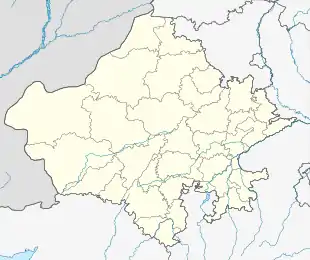 Location of Shri Mahavirji Temple | |
| Geographic coordinates | 26°41′43.7″N 76°55′48.78″E |
| Architecture | |
| Creator | Shri Jodhraj Diwan Palliwal |
| Date established | 400 years ago |
| Temple(s) | 5 |
| Website | |
| www | |
| Part of a series on |
| Jainism |
|---|
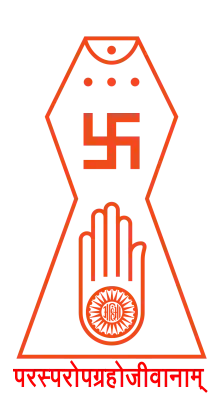 |
|
|
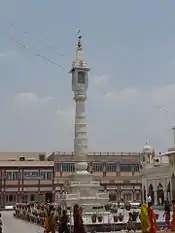
Temples in Shri Mahavirji
There are five temples in Shri Mahavirji.[3][4]
Atishaya Kshetra Shri Mahavirji Shree Chandanpur Mahavirjee is one of the miraculous pilgrimages of Jains. This pilgrimage is situated at Sub District in the Karauli district of Rajasthan.[5] Built at the bank of a river, this pilgrimage is a prominent centre of devotion for Jain devotees. Chandanpur Mahavirji temple is hailed as the heart of pilgrimages. This is a sacred place of the tradition of Jainism. Mahavirji was also had a Bhattaraka seat which became defunt in 1970.[6]
The iconic idol of Lord Mahavira, the principal deity of the pilgrimage temple, was found during an excavation. Some 'Kāmadhenu' (self milching cow) used to pour out its milk everyday upon a mound near Chandanpur village. It was surprising for the owner of that cow and the villagers. They excavated the mound. The villagers were overwhelmed with emotion on witnessing the emergence of the icon of the Lord. The news of appearance of the icon spread everywhere. The masses surged to have a glimpse. The wishes of people began to be fulfilled and thus a magnificent temple was built to ceremoniously install this uniquely miraculous icon of Lord Mahavira.
Getting impressed by this miraculous Bhagwan Mahaveer’s icon, Shri Jodhraj dewan Palliwal constructed a vast & magnificent temple here.[7] Between 17th and 19th centuries, this temple had been occasionally renovated. In respect of art, the magnificence of this temple is, on the whole, praiseworthy, but in view of its auspiciousness, Mahaveerjee is a pilgrimage without a peer. Millions of devotees visit this temple every year to pay their floral reverence at the feet of the Lord.
A marble-umbrella has been built over the spot where the icon had emerged, and a pair of foot-images ('Charan paduka') has been ceremoniously installed to symbolize the Lord's feet. The architecture of the temple is interesting and magnificent.
Drenched in the full moonlight, Chandanpur pilgrimage conveys the message of purity and peace to the humanity at large.
Architecture[8]
The main temple of Shri Mahaverji is vast & magnificent ornamented with so many pinnacles. This temple is surrounded by Dharmashalas (Guesthouses). The premises of Dharmashalas surrounding the temple is called Katla. In the center of Katla, main temple is situated. The entrance gate of Katla is very attractive and magnificent.
The temple is decorated with three sky high pinnacles. As one enters the main gate, there comes a rectangular ground and then there are seven gates to enter the Mahamandapa. After entering the temple we found a big shrine before us. An icon of Bhagavān Mahavira resembling to the miraculous principal deity and two other icons are installed here.
In Garbh Griha (Central Room of Temple), on the main shrine, the miraculous icon of Bhagavān Mahavira in Padmāsana posture, coral colored made of sandstone is installed with Bhagavān Pushpadanta in right side and Bhagavān Ādinātha’s icon in left side. There are so many agreeable ancient icons of other Tirthankaras, installed in this temple.
Exterior & interior walls of the temple are richly decorated with carvings and golden paintings of scenes from Mahavira's and Parshvanatha's life.[9]
16 mythological scenes are carved on the outer walls of temple. The sculpture of temple shows a high degree of skill in execution.
In the front of main gate of temple stands a 52 feet high Manastambha (Column of pride). Four Tirthankara icons are installed at the top of Manstambha in all directions.
Shantinath Jinalaya
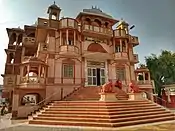
Shantinath Jinalaya (Temple): Shantinath Jinalaya at Shantiveer Nagar. In this Jinalaya Bhagavān Shantinatha’s 28 feet high colossus stands. Icons of 24 Tirthankaras and their Shasan Deotas are also installed here. An attractive sky high Manastambha is also standing here.
The main attraction of the temple is an imposing 32 ft high image of Lord Shantinatha, the 16th Jain tirthankara.
Bhagwan Parshvanath Jinalaya
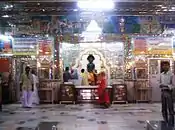
Bhagavān Parshvanatha Jinalaya, also called ‘Kanch Ka Mandir’ due its mirror and glass work, is situated in front of Sanmati Dharmashala. This temple was constructed by Late Bramhacharini Kamla Bai. Main idol of this temple is black colored idol Bhagavān Parshvanatha.
Kirti Ashram Chaityalaya
Kirti Ashram Chaityalaya is located in front of Shri Shantinath Jinalaya.
Bhavya Kamal Mandir
The Bhavya Kamal Mandir temple is recently built and located on the road connecting Shantinath Jinalya and Main Temple.
Discovery of the statue
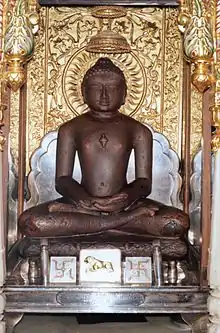
There was a mahajan community man who began to notice that one of his cows would come home in evening with empty udders. One day, he decided to follow the cow and finds that she goes daily to a "Tila" (a small hill of sand) and emptied herself of all the milk she had on the top of that hill. Puzzled by this scene, the man began to dig at that very spot and unearthed the statue of Bhagavān Shri Mahaviraji.
The main temple contains the statue of lord Mahavira and few others. The 'Mulnayak pratima' (main statue) is nearly 78 cm high and is carved out of sandstone. In this statue lord Mahavira is sitting in padmasana posture.
An annual fair is organized in the temple premise around Mahavir Jayanti (April) which attracts Jains and people from many other communities including Meena and Gujjar and religions in a great number.[1][10][5] The fair is for five days (starts 2 days prior to Mahavir Jayanti and end two days post Mahavir Jayanti) and ends with a colorful Rath Yatra pulled by Bullock cart. Many Jain sadhus or monks deliver religious discourses during this fair.[11]
It has a 78 cm high copper-colored idol of Mahavira in the Padmasana posture. About 175 km away from Jaipur it lies on the banks of Gambhiri river. The main attraction of the temple is an imposing 32 ft high image of Lord Shantinatha, the 16th Jain tirthankara.
Photo gallery
 Main Vedi
Main Vedi Shantinath Jinalaya
Shantinath Jinalaya 32 feet statue of Shantinath at Shantinath Jinalaya
32 feet statue of Shantinath at Shantinath Jinalaya Kirti Ashram Chaityalaya
Kirti Ashram Chaityalaya 'Charan' location from where main idol was excavated
'Charan' location from where main idol was excavated Kamal Mandir
Kamal Mandir 6th century Statue of Rishabhanatha at Jain Museum
6th century Statue of Rishabhanatha at Jain Museum
See also
References
Citations
- Stott & McCulloch 2014, p. 172.
- West 2010, p. 682.
- http://www.jaindharmonline.com/pilgri/mahavirji.htm
- http://jainsamaj.org/rpg_site/literature2.php?id=2535&cat=40&subcat=123&subsubcat=41
- Karauli & Rajasthan Tourism.
- Dundas 2002, p. 125.
- Getting impressed by this miraculous Bhagavān Mahavira’s icon, Shri Jodhraj dewan Palliwal of Bharatpur constructed a vast & magnificent temple here
- http://www.jainteerth.com/teerth/Mahaveerji.asp
- Titze & Bruhn 1998, p. 129.
- Bhatt 2005, p. 424.
- "Devotees throng Shri Mahavirji Temple in Rajasthan". Zee News. 28 April 2002.
Sources
- Bhatt, Shankarlal C. (2005), Land and people of Indian states and union territories, 23, Gyan Publishing House, ISBN 9788178353791
- Titze, Kurt; Bruhn, Klaus (1998), Jainism: A Pictorial Guide to the Religion of Non-Violence (2 ed.), Motilal Banarsidass, ISBN 978-81-208-1534-6
- Stott, David; McCulloch, Victoria (2014), Rajasthan, Delhi & Agra, Footprint Focus, Footprint Travel Guides, ISBN 9781909268395
- "Karauli". Rajasthan Tourism.
- Dundas, Paul (2002) [1992], The Jains (Second ed.), London and New York: Routledge, ISBN 978-0-415-26605-5
- West, Barbara A. (2010), Encyclopedia of the Peoples of Asia and Oceania, Facts On File, ISBN 9781438119137